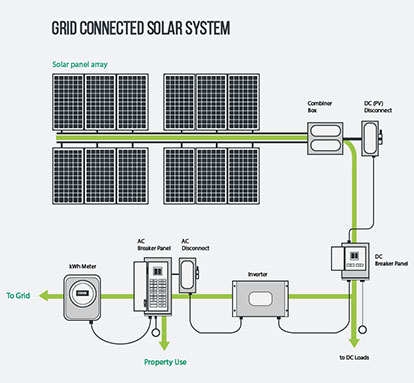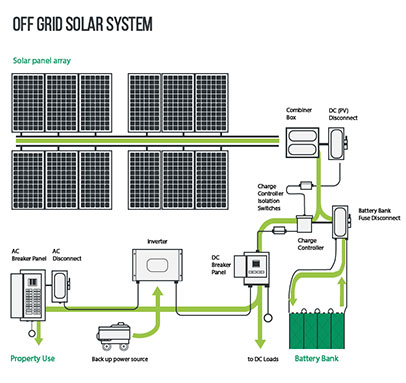Solar energy is a rapidly growing form of energy, and the solar energy market has also made considerable progress in the past decade. According to data, the global solar energy market has a compound annual growth rate of 47.4% based on the annual average solar system installed capacity.
In some major countries in the world, especially China, Germany, Italy, Spain, the United States, France, and South Korea, the federal government, state governments, and local government agencies have used tax rebates, tax credits, and other incentives to purchase solar products. End users, distributors, system integrators, and manufacturers provide subsidies and economic incentives to promote the use of solar energy in grid-connected and off-grid applications and reduce dependence on other energy sources.
But generally speaking, due to the political and economic instability in many oil and gas producing regions around the world, governments of many countries are taking active measures to reduce their dependence on foreign energy. Solar energy provides a very attractive power generation program and does not form a serious dependence on foreign energy.
At present, the solar power generation system has formed an industrialized application. It has the characteristics of modularization of battery components, convenient installation and maintenance, and flexible use. It is the most widely used technology for solar power generation.
As mentioned above, solar power generation systems are developing rapidly around the world, and various fields are beginning to try to use solar power generation, coupled with government support, to reduce dependence on traditional energy sources. In order to better introduce the solar energy industry, the commercial sector has naturally become the best pilot.
In places like hotels, commercial complexes, etc., solar power generation systems are installed on the empty areas of the roof to provide electricity for daily lighting and electrical appliances. The factory installs solar power generation systems in the open areas and on the roof of the factory and uses solar power to generate electricity for the factory machines during the peak hours of utility electricity prices. When the utility price is low, the factory will use utility electricity to power the factory machines. In some farms, due to their geographic location, the cost of city electricity wiring is relatively high. You can install solar power systems to provide sufficient power for your own farm equipment and daily electricity.
The installation of commercial solar power generation systems in the above fields can save their own companies a large number of electricity costs every year. Anern helps customize systems for a range of industrial solar power system applications.
The grid-tied solar power system is the most common type of solar power system. These systems are connected to your local electric grid as well as your home. In most states, the systems provide your power needs throughout the day and if your system produces more electricity than your home is using, it sends the excess back to the electric grid, selling your extra solar power back to the utility where it can be used by your neighbors and others.

Stand-alone solar power systems are incredibly useful in areas with limited (or completely unavailable) utilities. Using a completely off-grid solar system requires some extra equipment in the way of batteries and/or other energy storage devices, but the result is complete independence from any outside utility provider. One of the pitfalls of the off-grid solar system is that you often waste unused energy, as battery storage is limited. In certain places, there are also regulations that dictate that residences and businesses must be tied into a grid. Going off-grid means complete utility freedom, but if this is the route you take, it’s best to invest in some heavy-duty solar storage devices and to double-check all local laws and regulations to make sure off-grid is an option for your area.

Though it does require additional investment in the form of batteries, it is very possible to get the best of both worlds by building a solar system that only uses traditional utility power as a back-up. In this scenario, rather than funneling, your excess solar energy back into a power grid, you store it yourself. If you plan well and create enough storage, you can put yourself in a position of only using the power grid for cases of extreme energy use or very limited sunlight availability. The hybrid option is more and more realistic with the onset of new storage technology including the Tesla Battery.

Site assessment & feasibility study
Roof/ground space evaluation
Energy consumption analysis
Utility interconnection review
System design & engineering
Solar panel selection (monocrystalline vs. polycrystalline)
Inverter choice (string vs. microinverters vs. hybrid)
Mounting system (roof-mounted, ground-mounted, carport)
Permitting & approvals
Building permits
Utility interconnection agreement
Environmental/historic compliance (if applicable)
Installation process
Mounting & racking setup
Solar panel & inverter installation
Electrical wiring & safety checks
Commissioning & maintenance
System testing & performance verification
O&M plan: cleaning, inspections, monitoring software
Commercial solar panel: Anern understands that high-quality photovoltaic modules are fundamental to system performance as professional commercial solar panel supplier. Our advanced battery storage solutions enhance energy utilization efficiency for superior user experience. We offer a comprehensive range of solar panel technologies: Shingled PV modules for maximum space efficiency; High-performance monocrystalline silicon panels; Cost-effective polycrystalline silicon options.
Commercial solar battery storage: Solar power storage batteries play a crucial role in storing photovoltaic energy for reliable power supply. Anern premium solar LiFePO4 battery systems feature maintenance-free operation, deep discharge capability, and extended service life for optimal performance.
Commercial solar inverter: Anern's MPPT hybrid solar inverters combine high-efficiency charging with innovative power management technology. Our hybrid inverters for solar system optimize energy utilization while minimizing system costs. Contact us for tailored solar solutions that maximize your investment returns.

Make your business profitable
Zero your Electricity bill
Leading the solar solutions industry